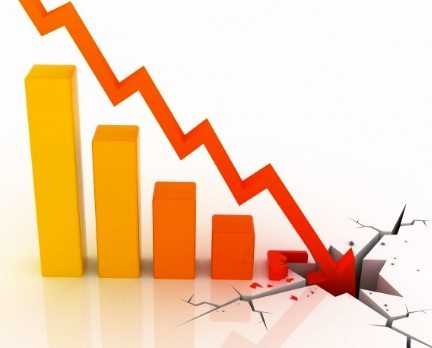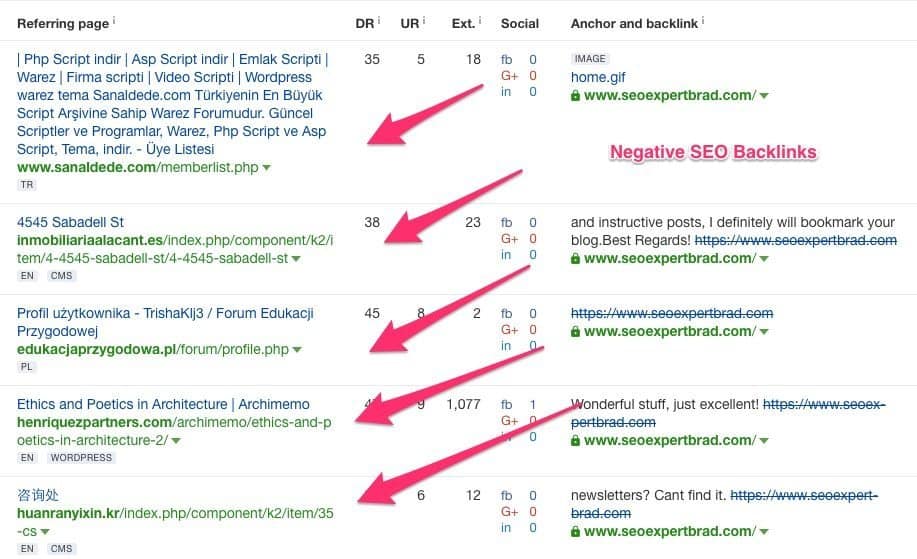Protect Your Website from Negative SEO With This Guide
So your first big question might be, What exactly is negative SEO?
Negative SEO practices include all malicious attacks designed to damage your website rankings and/or reputation online.
In some cases, negative SEO attacks may even result in Google penalizing or completely de-indexing your website.
I have assembled this guide to SEO that covers many black hat SEO techniques.
What will you learn about negative SEO in this article?
The first thing you will learn is that I will NOT be providing detailed examples nor explaining the specifics on how to carry out any Black Hat techniques.
If you are looking for info that teaches you how to pull off these types of shady harmful SEO practices, this is not it, so stop looking!
So why exactly am I writing this? Hacking is real.
Because of my own website recently came under negative SEO attack and, as a consequence, I can now definitely understand the dangers through my personal first-hand experience.
In simple terms, someone tried to harm my website by sabotaging my search engine rankings.
Fortunately, as I will detail here, I was able to spot the attack almost immediately and promptly mitigate any significant damage.
But make no mistake-
- Negative search engine practices exist
- These unethical techniques can definitely, negatively impact your business
- Learning how to identify these methods is the best way to combat them!
Simply stated- If your site is online, then you need to learn how to protect it from these malicious attacks.
Why not share the specifics?
Because providing information that’s blatantly unethical and dangerous would make me complicit with malicious attackers.
Why do some people choose to use Harmful SEO links?
Because negative SEO works…sometimes.
The immediate goal of positive SEO is to position your site in Google’s top search results so that you can maximize your visibility, increase click-through rate (CTR) and jumpstart your profitability.
Of course whenever there’s an opportunity to beat the system, damage your competition and score “easy” money, a certain percentage of unethical people will be more than willing to “do whatever it takes” to do precisely that.
Especially when deploying negative SEO tactics actually can be easier, faster and cheaper than employing ethically sound, “positive” SEO techniques.
As a direct result, the unfortunate current online business reality is- When your successful website starts to gain an envious reputation for “outranking” your competitors, you may sooner or later be forced to deal with one or even a series of these types of attacks.
What is Negative SEO?
Negative search engine tactics have been around for quite some time but gained increased popularity after Google released its “Penguin” update in April 2012.
As an indirect and unintended result of the stricter penalties imposed by Penguin penalty, Google inadvertently increased the overall effectiveness of some negative SEO tactics.
These external factors could now be relatively easily manipulated through the use of harmful SEO without your site’s consent or knowledge.
Quick Note: Negative SEO is NOT ALWAYS behind penalties, deindexing penalties, or sudden drops in Google rankings. In many cases, this is due to numerous other factors or circumstances.
Now please keep reading to learn how to efficiently identify using negative SEO alerts, and then determine what your best options to protect yourself.
Harmful Search Services Available by Hackers!
Based on the number of gigs from the online job freelancing site, Fiverr, which utilized negative SEO tactics, I would say a problem exists, and it is very real!
Also, there are numerous thread on blackhatworld with people openly discussing harming other websites.
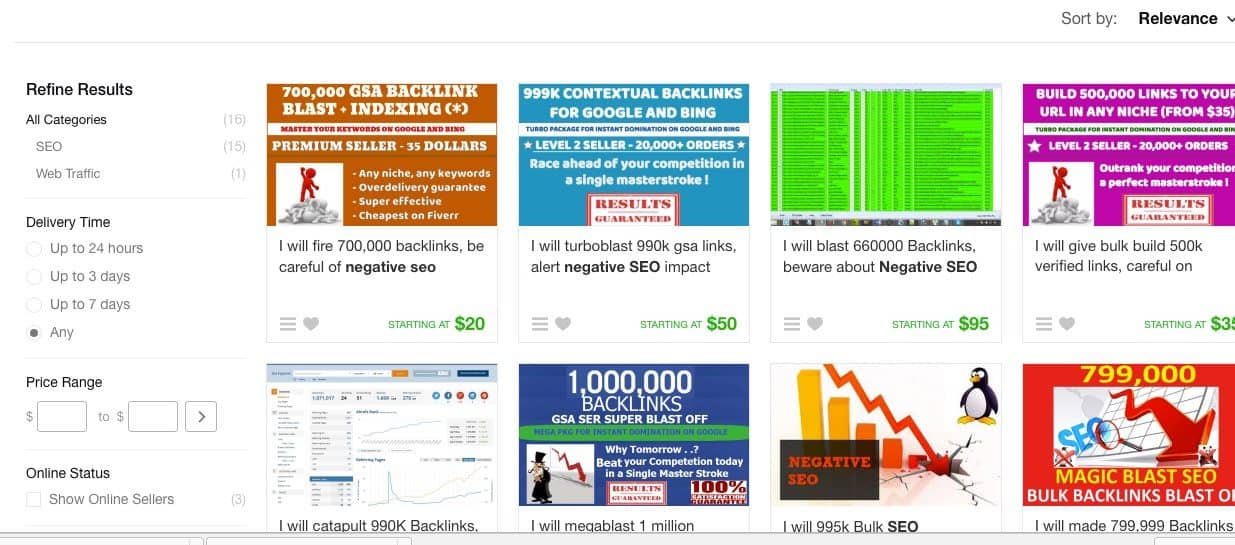
Buy Negative negative SEO services Available on Fiverr
Controversy remains on the subject today, but negative SEO is real and has happened to many victims, including my site. However, there’s an even easier way to demonstrate the reality of black hat SEO.
Just answer the following question-
If you go overboard with your link building (acquiring too many links too quickly from low authority sites, with too exact anchor text for example), will you find yourself in the sights of a revenue damaging Google penalty?
The obvious answer is YES…of course you will.
Anyone who’s spent any time at all using search engine tools has undoubtedly over-optimized their website just by overly aggressive experimenting with links and/or anchor texts.[/caption]
Can Your Business be Significantly Damaged?
Concise answer- Yes.
If the tactics are well-executed and deployed efficiently, your business can be dealt a swift penalty, since Google’s search engine algorithms will detect if/when you are attempting to “game” their system and improve your position in violation of its rules.
In general terms, there are two types of Google penalties- Manual action and Algorithmic.
- Google Manual Action Penalty
Manual penalties are the easiest to spot, especially if you are signed up for Google Search Console.
You will receive an almost immediate notification explaining what’s happened and this warning will often include instructions on how to act.That is why it is highly recommended that if you have not already done so… Sign up for Search Console!
NEAT TRICK: If you Google search for your domain with your operator site (site:domain.com) and see zero results, it is almost sure that you have already suffered a manual penalty and that Google has de-indexed you.
In case you suffer this kind of penalty (and after you have solved it) you can ask Google for a reconsideration request and will then have a good chance of being re-indexed.
- Google Algorithmic Penalization
This type of penalty is a bit more complicated as well as challenging to initially identify because, in this case, you will not receive a notification! I suggest you read my article on identifying Google penalties with a few tools.
The good news is that Google’s machine learning and AI is getting smarter and smarter to filtering out a negative attack.
Typically you’ll only realize you have been penalized after lost website rankings or suffering a decline in organic traffic visible in Google Analytics.
Also, in this case, you can not directly request reconsideration, and your solution will be significantly more complicated as well.
You’ll have to find out for yourself-
- The specifics of the problem
- Attempt to solve it
- Be forced (in the case of Penguin) to wait until Google re-crawls your website and all of your site’s backlinks.
Combating a large scale negative SEO attack is complicated, and unfortunately for your business, it is also far too easy to create new problems when trying to address or solve the original one.
What does Google say about this in their “help” documents?
“That is to say: it is you who must do everything possible to take precautions and defend yourself from the negative SEO, do not trust Google to step forward and get you out of the quagmire.”
If you carefully re-read the quote above you will see that Google does not state whether or not negative SEO exists.
Very different from what they state now, right?
That is to say: Something happened (Penguin?) that has changed the opinion of Google, and also that negative SEO is a new reality.
The Top Five Most Common Types of Negative SEO
(and how to detect then solve them without further damage)
1. Malicious Link Building
This is the most common negative SEO practice and the most frequent one you will most likely experience.
Fortunately, it is not often the most effective, especially if your site is older and already has established authority with content marketing or social media.
2. Low-quality Blog and Forum Comment Backlinks
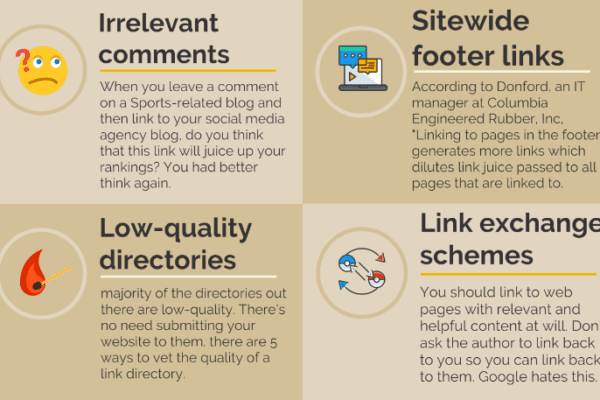
This problem is one of the most common black hat tactics due to it being relatively inexpensive and straightforward to execute. Almost anyone can spam comments and insert spammy links in abandoned blogs or online forums which lack regular moderation. As a standard example, when you regularly monitor your backlink profile, you will be able to quickly notice hundreds or even thousands of inbound unnatural links that appear suddenly, which should alert you that you have been attacked.
3. Negative off-page SEO, Malicious Low-quality links
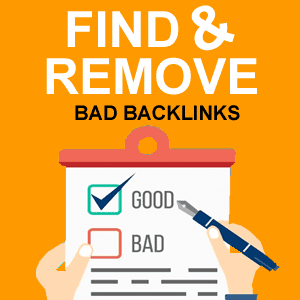
This negative SEO tactic a bit more of a severe problem, especially if the low-quality links are created rapidly, typically at a speed that’s nowhere near usual to your site.
With this attack, you run the risk of Google thinking that you are attempting to aggressively position yourself by buying paid links and, they will penalize you.
What can you do in this case? I recommend-
- If you have not already done so, immediately register your website in Google Search Console, and then regularly, scrupulously monitor your portfolio for all links, primarily focusing on those you have not consciously created yourself.
- Subscribe to a quality tool, such as Majestic or Ahrefs, and then SEO audit your backlinks frequently. A link audit is a required starting point.
- If you use Majestic, you can receive automatic alerts by email when the tool detects new link spam to your domain.
- Whenever possible (complicated in the case of an attack) try to contact the website owner and ask him to remove the link spam, or at least use the “no follow” attribute to decrease his strength.
- Use the “disavow tool” (disavow).
- Review detailed information about disavowing and how to do it below.
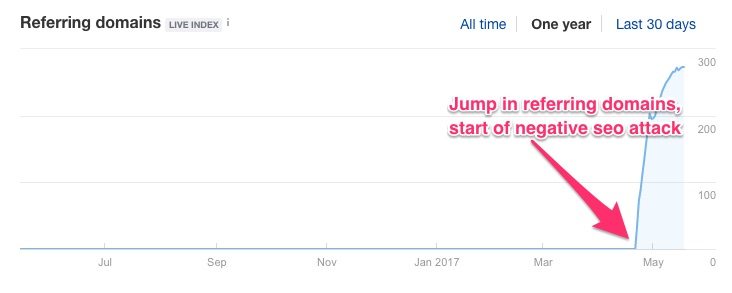
4. Spammy Anchor Texts
Although it seems counter-intuitive, the worst negative SEO spam attack you can receive is precisely the one that simulates a “reasonable” (but abusive for Google) SEO strategy that you can conduct yourself. That is why it is increasingly essential that, for long-term positioning, you try to stay as far away from spammy SEO as Google considers questionable. If you are only positioning strategy is to create spammy links in abandoned blogs or with exact commercial Keywords, it is very easy for you to drop the first attack which merely amplifies what you are already doing.
Examples of Mass Links with Text Anchor containing Spam-
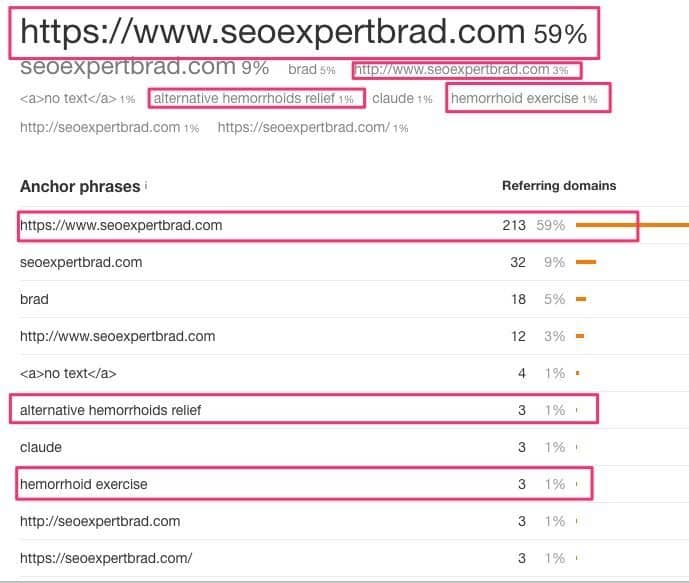
Sometimes, by checking your links with Search Console, AHREFS, or Majestic, you may find that the anchor text of your links suddenly contains some “strange” keywords. If these links point you to anchor text that is not specific to your content, (like all those porn-related, piracy-related, or Keywords in a different language) usually you do not need to worry. It is not unusual for this types of attacks to affect the positioning of your “good” Keywords or trigger a penalty.
6. Massive links with Text Anchor of Main or Commercial Keywords
If you are attacked with a massive campaign of “do follow” links, which also point you to the Keywords that are typically associated with your site … then this attack can be severe.
This is because it is possible that by doing so your attacker is or can become Penguin prone.
If this happens, in addition to devaluing all the Keywords of the External Links you currently have (both good and bad), the same would happen to the anchors of your internal links.
That is to say; Google would believe that you are now abusively using anchor text in your backlinks and would then nullify the value of these Keywords; both the “good” links obtained and the “bad, spammy, or unnatural” links your attacker has created. Penguin depreciates all links containing those words arbitrarily.
In practice, this means that you would stop positioning yourself for those words and that would make it very difficult for you to do so again.
What can you do in this case?
- Carefully check your backlink profile, especially the anchor text.
- If you keep a historical record of your links (which I highly recommend) look at the record before the attack when you were positioning for your Keywords.
- Once you know what profile Google considered to be “right,” try to return to it by reducing the density of the affected Keywords in any way you can.
- But do it progressively and patiently: if you were (for example) with a 3% density for a particular Keyword, and now you are at 6%, don’t go down to 3% at a stroke. Drop to 1% and wait a week. If you do not improve your position, drop another 1% and wait another week, etc.
- Continue to build links, or start getting quality links that point to your website using your Brand Keywords, or Neutral Keywords. Do not re-use Exact Keywords until the anchor density caused by the attack is diluted.
- Why Brand Keywords, not Commercial or Top Keywords? Because of this way, when these disappear or weaken, you will not run the risk of suddenly finding yourself with a profile of over-optimized links.
What are Brand Keywords and Neutral Keywords?
For my website, Branded Keywords would be: “seoexpertbrad”, “Brad Shaw,” “Brad,” “Blog of SEO expert,” etc. And Neutral: “Click here”, “website”, “here”, etc.
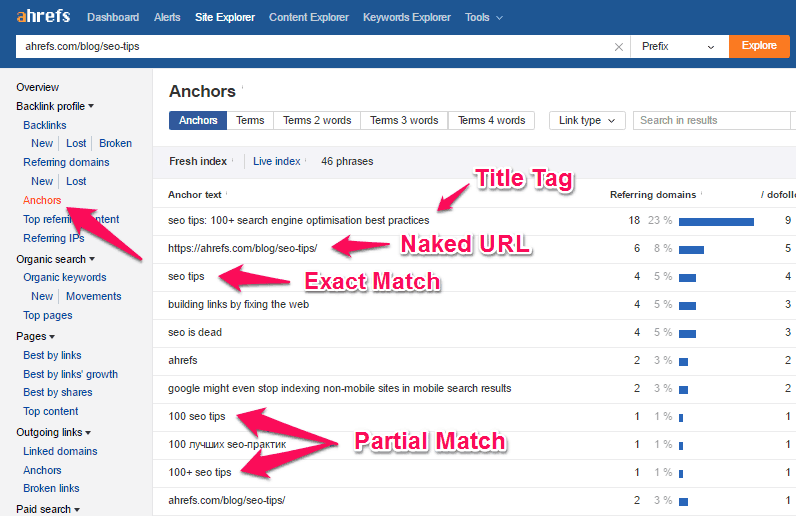
Image from Ahrefs.com
SEO Link Building With Toxic Domains
Admittedly you have read “tricks” or “techniques” to reduce penalty risk by “moving” your content to another domain and redirecting search traffic.
If you have tried it, you have no doubt discovered that penalties were severe and, sooner or later, they affected your new domain.
And just as with other negative SEO techniques, an adversary can take advantage of this situation to attack you by redirecting a penalized domain to yours, with the intention that the penalty will catch you.
What can you do?
- You can detect this type of attack if suddenly, and without any action on your part, the authority of your domain or a particular page decreases quickly.
- The first line of defense is to include the redirected domain in your Disavow file.
- But do not stop there; try to locate where the toxic domain is hosted then contact their support to explain the situation and ask them to eliminate the redirection or suspend the account depending on the case.
Social Engineering Attacks
Of course, it is not always easy to get quality organic links.
Once you obtain them, you would like them to remain active, while you are gaining authority and increasing your position. Unfortunately, this slower process does not always appeal to certain unscrupulous competitors who campaign to try to have them withdrawn.
How do they do that?
With some of the oldest, shadiest techniques still available:
- Social Engineering
- Supplanting your identity on social media
- Posing as others.
Just send an email on your behalf to the owners or publishers of the sites and request that they remove them because “Google has marked them as spam.” Or you can also pose as a positioning agency that works for you and is currently “cleaning” or “restructuring” your profile links.
The sad thing is that some webmasters can remove your link without verifying the origin of the email.
Fake Reviews Online Can Affect Search Engine Rankings
Another technique, which is, unfortunately, becoming more fashionable, is to create a lot of false reviews that and then publish them in pages like Google’s My Business.
This achieves two goals at once:
- Attacks your positioning by inviting penalties
- Damages your online reputation

What can you do?
- Regularly monitor and check your most important links and if one or more of them suddenly vanish then contact the party responsible for the website in question to find out what happened.
- Monitor the reviews of the sites where you publish the data of your company to report attacks of this type.
This is not negative SEO, but an honest review. Granted, he could use an ORM, or online reputation management expert.
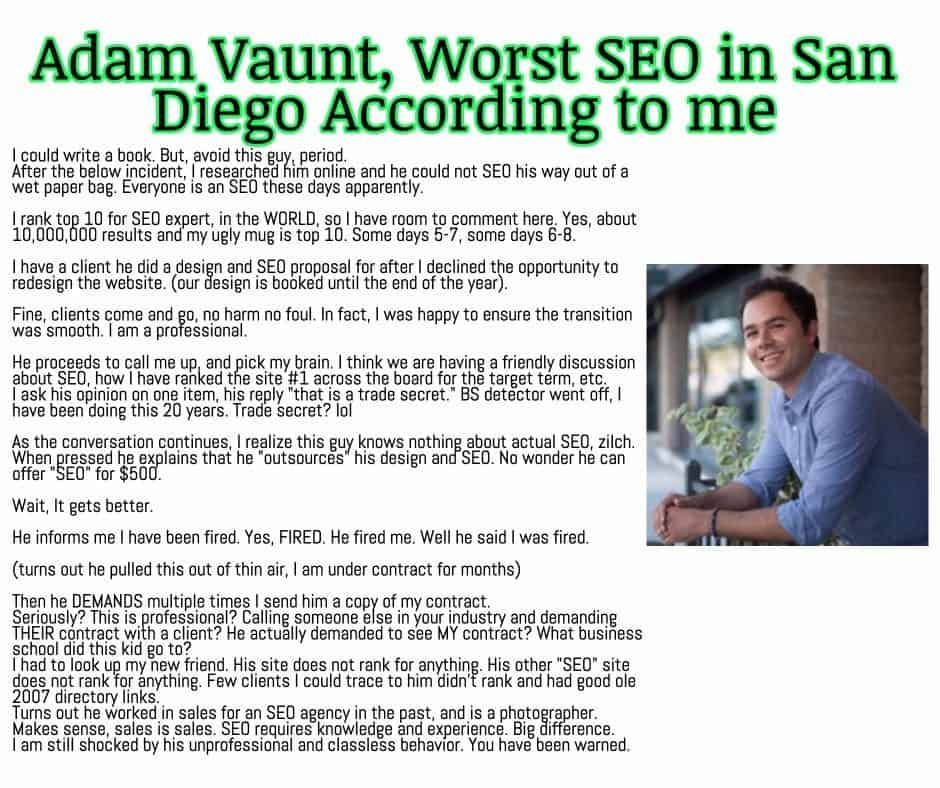
Adam Lindquist from San Diego California is among the most negative aspects of online marketing in my opinion.
Duplicate Content Attack
Surely you read that duplicate content can negatively influence your positioning. Again this problem can be used by your competitors. How can they do it? Simply by creating identical copies of your articles or web pages and then publishing them in other domains. When there is a multitude of copies of the same article, Google can be confused and thus position others ahead of the original, yours. Especially if the site in which it is re-published has authority as well as a related theme. Also, if the attacker manages to index your content before you do, Google may consider your attacker to be the original author, a full-blown robbery.
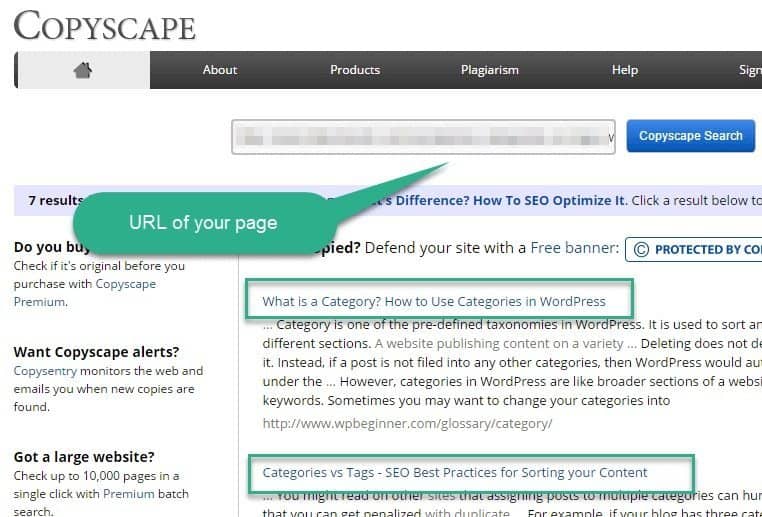
What can you do to prevent this?
- First, immediately index your articles as soon as they are published. If Google indexes your content first, they will know it is the original and discard the rest as copies. This will prevent content duplication or a penalty from your content being duplicated among many sites.
- Make sure you use a canonical tag on every page.
- Contact the webmaster and ask him to remove the duplicate content: it is possible that they have also been hacked and are publishing your content automatically without his knowledge.
- Contact the hosting where the domain that is copying is housed and report the problem.
- Use Google’s spam report tool to report the problem, and request that they remove the duplicate content from the index.
- Create Google email alerts for the title of your articles and will notify you automatically when an identical copy appears.

Negative ORM (Negative Management of Online Reputation)
As read throughout this article, anything that positively affects you can also do so negatively.
Therefore, if you can work to obtain a good Online Reputation (ORM), your opponents can equally strive to get it dirty; that is, create reviews or negative publicity about your company or your products.
This is not entirely worrisome if this “bad press” fails to appear on the first pages of results. But when you start to dominate the second page of Google for your Commercial Keywords or Brand … you have a reputation problem.
What can you do?
- First of all, it is essential to control your Online Reputation, and the easiest and most effective way to do it is with SERPWoo: it will automatically notify you when other results you have not created begin to climb positions, and before it is too late.
- Discovering negative results as soon as possible will give you the opportunity to react, creating and positioning positive content that “covers” and “pushes down” adverse content.
Injection of malicious code
You have already seen that a bombardment with your main Keywords as Anchor text can be quite unpleasant.
But what happens when you discover that there are a lot of spammy bad backlinks pointing to a specific page in your link profile, with unknown anchor text?
For example, hundreds of spam links pointing to an inside page of your website with “viagra,” “casino,” etc. When this happens, it is possible that your site has been hacked and that the attacker is using it as a Parasite to position other pages.
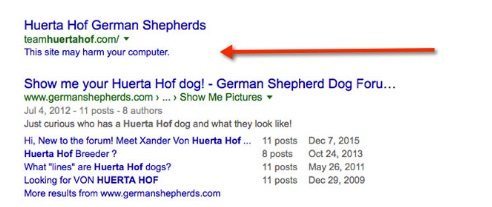
One of a lesser-known Black Hat tactics is to take advantage of some weakness in your site code then inject and hide code with links to pages they try to position. WordPress is especially susceptible to this.
That is, they take advantage of the authority of your website, as a parasite, then create links to the hacked page with your objective keywords to increase their relevancy.
You run the risk of Google blocking access to your site if it detects malicious code or thinks you have been hacked.
Make sure you monitor your site using Google Webmaster tools.
What can you do?
- If you suspect that you are a victim of this attack, but do not see anything unusual in your website code, examine the dubious page with Search Console’s “Explore as Google” tool.
- It is possible that malicious content remains hidden when viewing the page or even when reviewing the code. But you can reveal it by using Explore as Google because for this technique to work Google must be able to “see” and then index the link.
- Schedule time to regularly check your link profile in Search Console and SEO tools like Majestic, to detect this situation as soon as possible.
- Use Secure Hosting, which has an excellent technical support that you can contact for help.
- Always keep your WordPress and plugins up-to-date, and use a WordPress plugin like Wordfence that adds extra security.

Use the Disavow Tool to Disallow Toxic Links
When attacked with low-quality, toxic, unnatural or fraudulent links it is time to review, analyze them, and then determine if you want to disavow. John Mueller and Matt Cutts from Google have both discussed at length the use of the disavow.
Google’s Disavow Tool, can be carefully used to effectively un-authorize links that may be negatively affecting your position.
However, beware, this tool is expert level only, and definitely should be your last option!
If you are unsure exactly what the story is, read Number 5 first before you decide to take action. Alternatively, hire a professional search engine consultant or company.
Disavowing is a Controversial Topic
We all know that Google can detect patterns of links, texts, social interaction and more, and also that attempting to precisely eliminate links is another pattern that, contrary to what many may think, will also turn around and bite you.
How is that even possible?
Imagine that you created links from a PBN or private blog networks well hidden from the eyes of search engines, generated too many in much too short a period.
Beginners Guide To Analyze Your Backlink Profile
The first thing to do is to investigate the links that your website has achieved naturally, as well as those that you have created yourself.
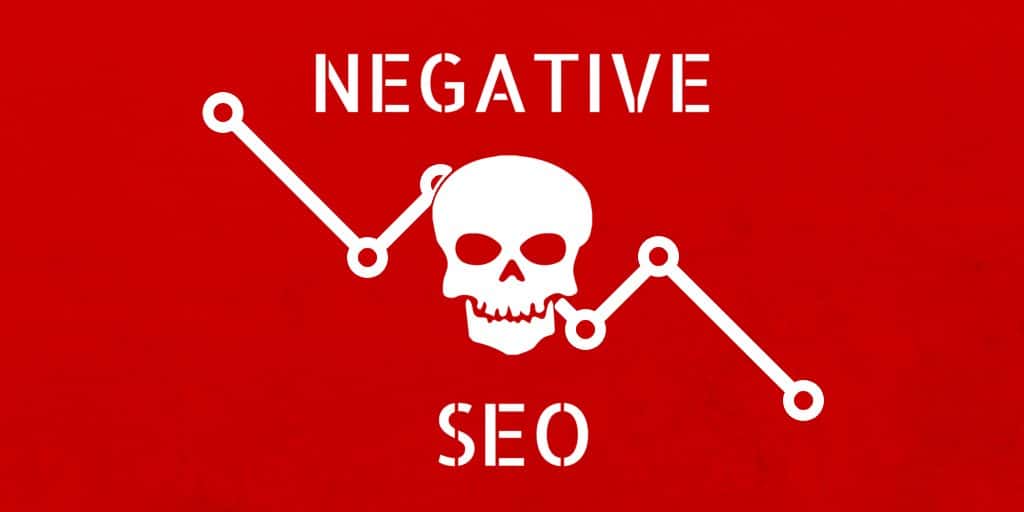
Beginners Guide To Analyze Your Backlink Profile
The first thing to do is to investigate the links that your website has achieved naturally, as well as those that you have created yourself.
To do this, just analyze your domain with Site Explorer from Ahrefs.com Majestic, or SEO powersuite and then track the referring domains that point to your website. They are my favorite website auditors, and I usually use a combination of the three.
You can also use Search Console by accessing Search Traffic to your site, although it does not show updated results like the other two tools we recommend.
In both, you can see growth graphs of your links; so when you find very large peaks, you may need to pay strict attention.
Now create an Excel file and write:
- Domain Ranking (DR). The more, the better
- Ranking of Ahrefs, The lower, the better.
- Alexa ranking. The lower, the better.
- Trust Flow. The bigger, the better.
- Citation Flow. The higher, the better.
- The number of links you receive.
- Reference country. If they are from Russia or China, 99% are spam. Try to get links only from countries where you want to position.
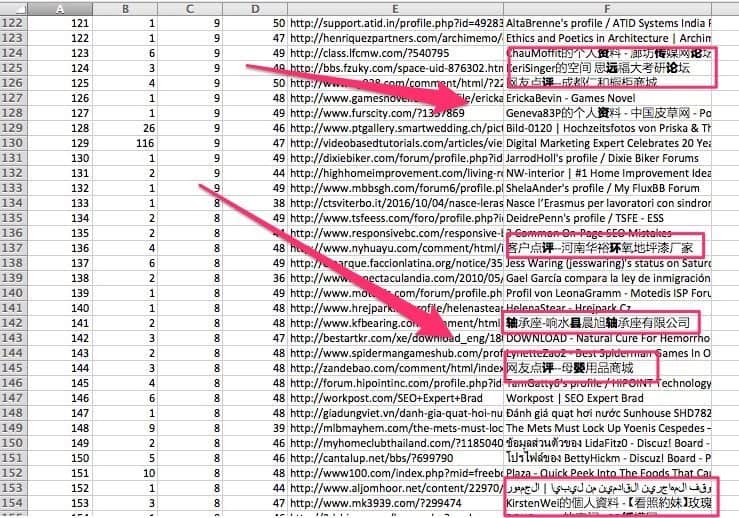
spreadsheet of malicious backlinks
Negative SEO example, spreadsheet of malicious backlinks[/caption]
Once completed, the most suspicious links you need to immediately disavow will be visible.
Inside webmaster tools search console, manual actions you can also see if/when Google has detected suspicious links and penalized your website.
For example, seoexpertbrad.com receives links from such dubious websites as- popular.jp0.Ru, listofdomains.org, list-of-domains.org or webnamelist.com.
All of these are domain directories that Google considers as link farms and, in addition to this, your domain may unknowingly appear listed next to adult websites or casinos.
So we are ready to disavow links:
- We created a .txt document (encoded in UTF-8 or 7-bit ASCII)
- We have included the referring domains that we want to remove one per line.
Now if/when you want to disavow an entire domain-
- Start your line with “domain: thedomain.com,” and if it is a specific page, include only the absolute URL.

Disavow also includes comments to help you remember when you added
- Add the links and domains.
- Save changes.
- Access the Disavow Tool website in Search Console.
- Choose the web and upload the file (up to 2 MB).
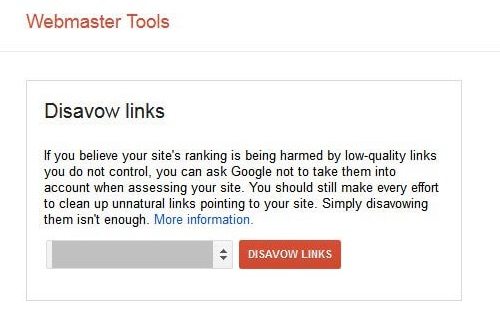
Disavow feature inside Google Search Console
NOTE: The Disavow Tool is not a tool against spam, i.e., Google does not take into account the websites listed to penalize them (at least for now).
Always try to eliminate low-quality links yourself by directly contacting the webmaster, but if this is not possible, then use Disavow Tool.
Once uploaded, it will inform you if the file is correct and the number of URLs or domains it includes, and will send you a copy with an email like this-
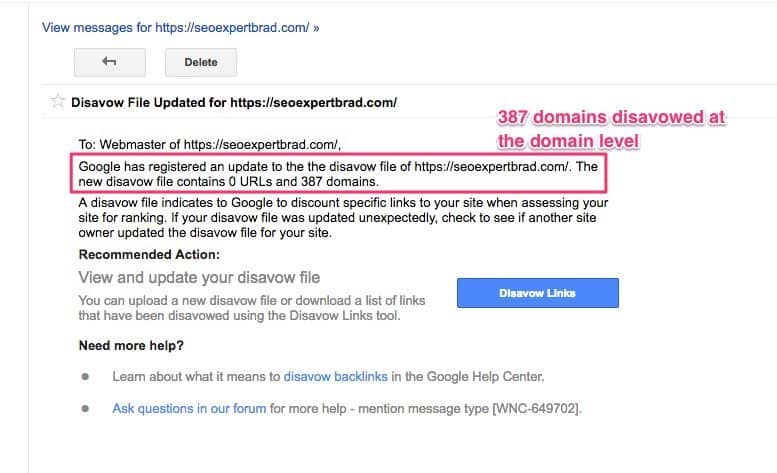
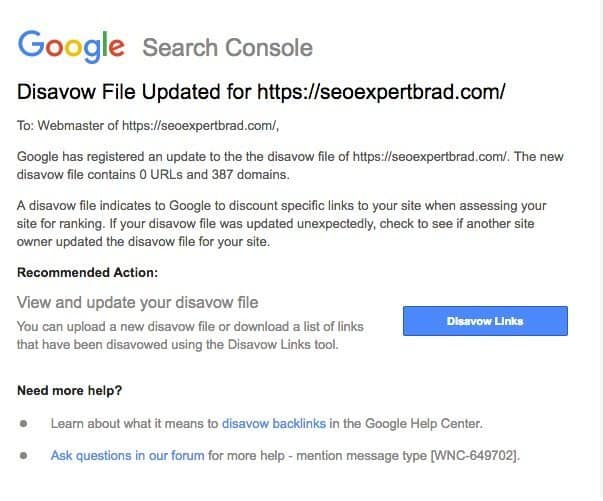
Disavow feature inside Google Search Console[/caption]
Which Links Should I Disallow?
If you want to build a good profile to your website, natural is always best; so write high-quality content, and the links will come. We all know that this can be a slow process, while your competition might be generating artificially to improve their positioning.
You do not have to fall into this trap.
Instead, more carefully review any linking domains.
- Low-quality directories -Their poor design is a sure sign that they are or will be penalized.
- Link farms- There’s no classification here; they appear one after another without any criteria.
- Content blog farms- Blogs networks where you can publish optimized content. Do not confuse with guest blogging.
- Finally, if you create links, always track your anchor text ratio. This will prevent Google from detecting an over-optimization or unnatural link pattern.
As you can see, the process of disavowing is relatively simple, but you have to be very clear which links you want Google to ignore so that it does not negatively impact your site’s positioning.
FAnd the same if most of your Backlinks use your main Keyword as anchor text- This would not be natural. Use latent semantic keywords.
Just try to have a “normal” link profile, with enough variety of “good”, “bad”, “follow”, “nofollow”, with anchor “branded”, anchor “neutral”, etc.
In Closing, Do you Need a Negative SEO Expert?
Negative SEO is an unpleasant reality which can happen at any time.
It is a terrible and unethical business practice, but certain parties will continue trying to use it. Especially if/when you are in very competitive niche markets.
The best way to defend yourself and to mitigate your penalty risk is to increase the authority of your site naturally.
I have found negative SEO does not work when you have a strong foundation with Google, think content marketing with blog posts, and authoritative backlinks.
Also, monitor backlinks on a regular basis.
The higher quality your website maintains, the less likely you are that Google will penalize you in the event of an attack.

